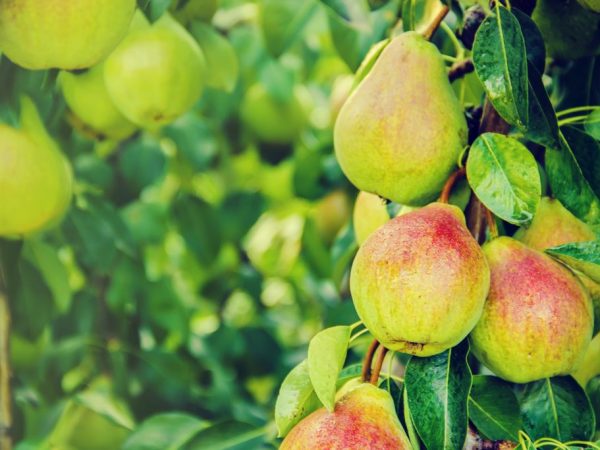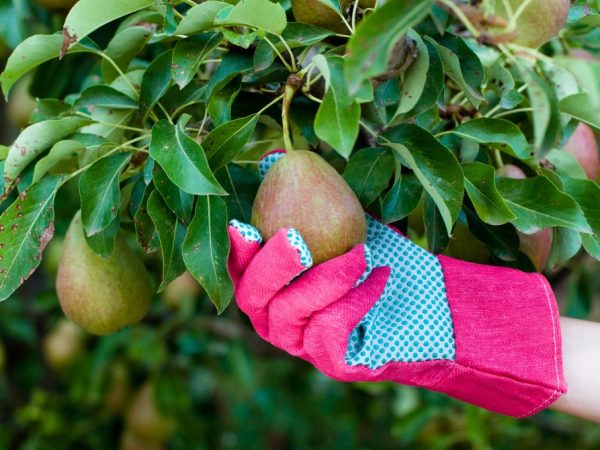Characteristics of the Vekovaya pear variety
Pear Vekovaya is a variety that has been bred for over 20 years. It is still popular among gardeners today, thanks to its stable yields.

Characteristics of the Vekovaya pear variety
Characteristics of the variety
The Vekovaya pear variety was bred by crossing the Ussuri and cultivated pears.
Description of the variety:
- self-infertile;
- begins to bear fruit in 3 - 4 years after planting;
- yields are stable;
- fruits ripen by the end of September;
- average winter hardiness;
- disease resistance is above average.
- drought resistance is average.
The tree was bred for the Siberian and Ural regions. In areas with severe frosts and little snow cover, additional shelter is required for the winter.
The age-old needs a pollinator tree. A suitable variety is Severyanka. ...
Description of the tree
The description shows that an adult tree reaches a height of 5.5 - 6 m. The crown with a radius of up to 5 m is compact. Young shoots are light brown. Leaves are ovate, slightly elongated. Blooms in late May. The flowers are white, large.
The Secular Pear has a deep root system. It is recommended to plant in places where there is no close groundwater.
Description of the fetus
The fruits of the century-old autumn pear ripen together. They need to be removed from the tree quickly, a maximum of a week in order to prevent rotting.
The fruits of the Age have the following characteristics:
- the weight of one fruit is from 140 to 220 grams, but there are also giants weighing about 400 grams;
- the pulp is white;
- dessert taste;
- keeping quality is about 1 month.

You need to remove the fruits quickly to prevent rotting.
The fruits are typically pear-shaped. The skin is thin, greenish-yellow. Ripe pears are more yellow with a pronounced blush on one side.
The pulp is juicy, sweet and sour. Usually consumed fresh, but also suitable for winter harvesting.
Boarding time
Planting a seedling is carried out in spring or autumn, choose the south side, protected from the wind. The soil must be fertilized with organic matter in advance.
In the southern regions, it is better to plant a pear in the fall, and in the northern regions - in the spring. This is due to the length of the adaptation period.
Spring
In spring, the crop is planted when the temperature at night no longer drops below 5 ̊C - 7 ̊C. The place where the seedling will grow is prepared in the fall - they dig a hole, add a mullein (or other potassium-phosphorus fertilizers) to the bottom, ash and sprinkle it with earth. In the spring, before planting, the pit is well spilled, nitrogen fertilizers are applied.
Autumn
Autumn planting differs from spring planting in that nitrogen fertilizers are not applied, since they stimulate the growth of the green part. You need to plant three weeks before the first frost.
When planting, you need to monitor the root collar. It cannot be buried in the ground, since the tree will begin to bear fruit later, and the amount of the crop will be scarce.
Care
The Age-old pear responds well to regular feeding. Before the beginning of the flowering season, nitrogen fertilizers and organic matter are introduced into the trunk circle. Be sure to whitewash. This protects the bark from sunburn, cracking, infection and pests.
Crown cleaning
In the fall, you need to remove rotten fruits (if any), old branches, leaves. Water the trunk circle well, apply phosphorus fertilizers. If there are severe frosts in the region, then they additionally add mulch (sawdust, rake the earth) to protect the roots from frost. The trunk itself is tied with burlap or other material.
General recommendations
- prune (form) the crown annually;
- once a season, apply fertilizing (spraying) with mineral fertilizers;
- during long periods of drought, add extra water.
After winter, inspect the crown. If there are frozen branches, then remove them, and cover the cut area with garden varnish.

For good fruiting, the pear needs to be fed regularly.
Pests
The description shows that the variety is susceptible to such insects as aphids, moths, ticks, pear and leaf gall midge, tube-worm, flower beetle.
For the prevention of pests in the spring, in mid-April, they are sprayed with preparations (Bordeaux mixture, Fitoverm, Iskra-bio, Healthy Garden). These treatments can be repeated once a month, but no later than 20 days before harvesting.
Diseases
The variety is resistant to diseases such as scab, fire blight. It is less resistant to other diseases, therefore, when the leaves curl, wilting, yellowing of the ovary or other signs of deterioration in development, they are treated with fungicides.
With timely application of top dressing and preventive spraying, fruiting is consistently good. When applying mineral fertilizers, the norms are strictly observed in order to prevent burns.
Conclusion
The Century autumn pear variety is unpretentious and fruitful, it takes root well in most areas. The cultivation does not require special knowledge or skills.
The variety is most appreciated for its annual harvests and delicious juicy fruits. Despite the fact that many self-pollinated species have been bred today, resistance to diseases and pests leaves this hybrid popular with many gardeners.


